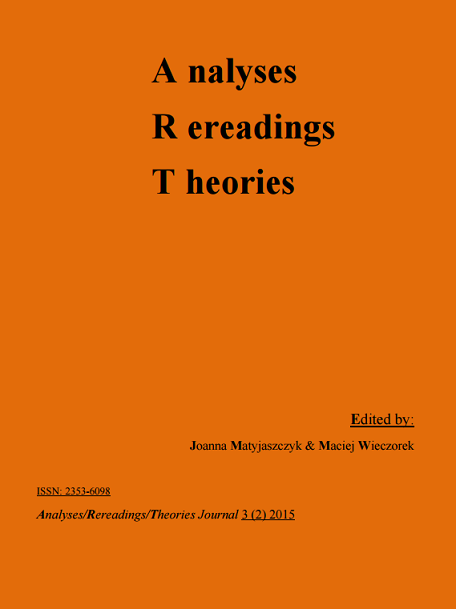Roll a Hard Six: Losing Your Noodle in Raymond Federman’s Double or Nothing
DOI:
https://doi.org/10.18778/2353-6098.3.06Keywords:
surfiction, Holocaust, concrete novel, psychologyAbstract
Raymond Federman’s Double or Nothing is a convoluted representation of the mentallyunstable mind existing as a series of six characters that are at once separate and conjoined: the horrors and traumatic events of the narrative past dismantle the unified subject into a series of schizophrenic sub-personalities, parts of the destabilized Author’s psyche, existing as separate fragments that eventually collide. Further, the imaginary room emerges as the Fifth Person, promising, but failing, to be a central stabilizer of the other fractured selves. Finally, the design of the text echoes the patterns of the traumatized mind, illustrating the inability of a narrative to construct a stable, unified subject and demonstrating the inadequacy of traditional narrative forms. The text, with its obliterations, cropped phrases, and pictorial manifestations, becomes the Sixth Person. However, in the end, the text shows that the past cannot be erased, explained, or reversed; neither can the experimental nature of the novel reach beyond the traumatized, schizoid subject to represent the horrors of the past that caused the Author’s psychotic breach. Federman has rolled a hard six that will repeatedly fragment and unite, just as the traumatic past continues to repeat itself as one that defies representation.
References
Barthes, Roland. “The Death of the Author.” Modern Criticism and Theory. Ed. David Lodge. London; Longman, 1988. 167-72. Print.
Google Scholar
Davies, Paul. “Samuel Beckett.” The Literary Encyclopedia. Literary Dictionary Company, 8 Jan. 2001. Web. 17 Jan. 2015.
Google Scholar
Hutcheon, Linda. Narcissistic Narrative: The Metafictional Paradox. 2nd ed. Waterloo ON: Wilfred Laurier UP, 2013. Print.
Google Scholar
Federman, Raymond. Double or Nothing: A Real Fictitious Discourse. Chicago: Swallow, 1971. Print.
Google Scholar
Federman, Raymond. “Surfiction – Four Propositions in Form of an Introduction.” Surfiction: Fiction Now and Tomorrow. Ed. Federman. Chicago: Swallow, 1975. 5-15. Print.
Google Scholar
Oppermann, Serpil and Michael Oppermann. “Raymond Federman‘s Double or Nothing: A Prolegomena to a Postmodern Production Aesthetics.” American Studies International 35.3 (1997): 42-66. ProQuest. Web. 3 Mar. 2014.
Google Scholar
Pearce, Richard. “Enter the Frame.” In Surfiction: Fiction Now and Tomorrow. Ed. Raymond Federman. Chicago: Swallow, 1975. 47-57. Print.
Google Scholar
Rizza, Michael James. “Postmodern Alienation: Projecting Worlds/Feigning Subjects.” Diss. USC, 2010. ProQuest. Web. 3 Mar. 2014.
Google Scholar
Sartre, Jean-Paul. “Existentialism Is a Humanism (Lecture given in 1946).” Existentialism from Dostoyevsky to Sartre. Ed. Walter Kaufman. Trans. Philip Moiret. Seattle: Meridian, 1989. n. pag. marxists.org. Web. 18 Jan. 2015.
Google Scholar
Sass, Louis A. “Interspection, Schizophrenia, and the Fragmentation of the Self.” Representations 19 (1987): 1-34. JSTOR. Web. 3 Mar. 2015.
Google Scholar
DOI: https://doi.org/10.2307/2928529
Trueman, Leslie Doris. “Images of the Center of Schizophrenia Myth, Text, Theory.” Diss. Rutgers, 2002. ProQuest. Web. 3 Mar. 2015.
Google Scholar
Wielgosz, Anne-Kathrin. “Displacement in Raymond Federman‘s Double or Nothing Or, Noodles-and-Paper-Coincide.” J of Narrative Technique 25.1 (1995): 91-107. JSTOR. Web. 3 Mar. 2015.
Google Scholar
Downloads
Published
How to Cite
Issue
Section
License

This work is licensed under a Creative Commons Attribution-NonCommercial-NoDerivatives 3.0 Unported License.









